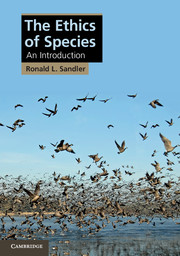Book contents
3 - The conservation biology dilemma
Published online by Cambridge University Press: 05 November 2012
Summary
Conservation biology is concerned with the viability of species and ecosystems that have been impacted by human activities. It is an applied discipline. Conservation biologists develop, evaluate, recommend, and implement ecosystem and species management strategies, practices, and policies. At the core of conservation biology, as well as many forms of environmentalism, is a commitment to the value of species and biodiversity. Here is a classic and representative statement of the “Normative Postulates” of conservation biology:
“Diversity of organisms is good.”
“The untimely extinction of populations and species is bad.”
“Ecological complexity is good.”
“Evolution is good.”
“Biotic diversity has intrinsic value.”
Several of these value claims were discussed and evaluated in Chapter 2. For now, what is crucial is that these are the commitments that inform the perspective of many (if not most) conservation biologists and environmentalists. As a result, conservation biology studies biodiversity, individual species, and ecosystems, as well as the human systems that impact them, toward the end of developing and implementing strategies to protect species and maintain biodiversity under anthropogenically threatened conditions. The goal of conservation biology is not to understand and document extinctions, but to prevent them. In this chapter, I argue that macro-scale anthropogenic ecological change, and global climate change in particular, generates something of a dilemma for conservation biology. Its overarching goal of species preservation is put into tension with some of its basic “Normative Postulates.”
- Type
- Chapter
- Information
- The Ethics of SpeciesAn Introduction, pp. 47 - 74Publisher: Cambridge University PressPrint publication year: 2012



